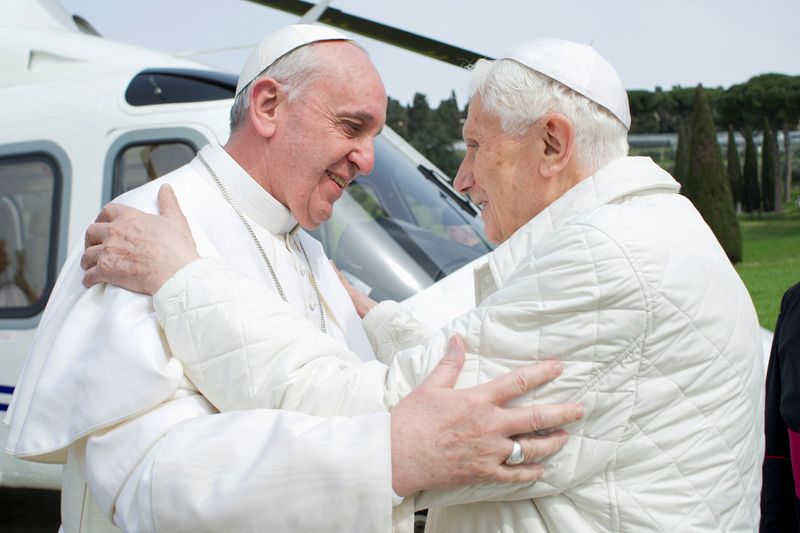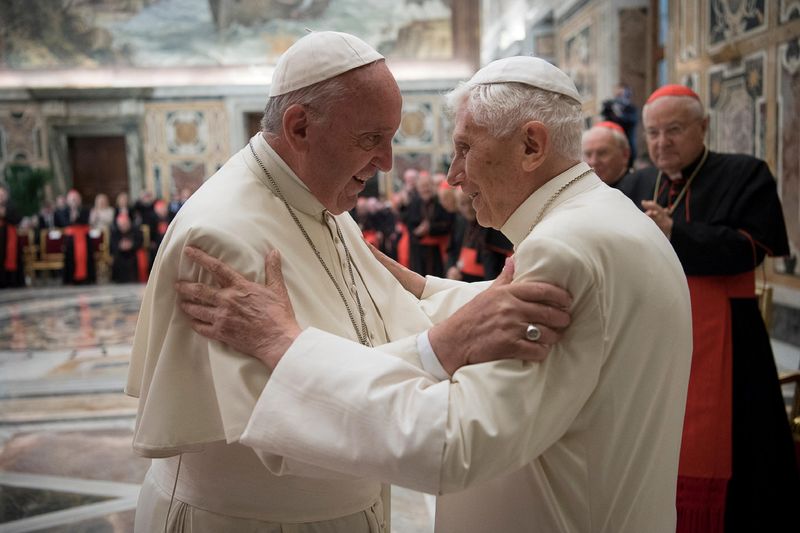By Philip Pullella
VATICAN CITY (Reuters) - When Pope Benedict shocked the Roman Catholic Church in 2013 by announcing he would resign instead of ruling for life, he promised to stay in the Vatican "hidden from the world".
He kept only half that promise. Benedict may not have been seen much, but he certainly was heard.
Benedict wrote, gave interviews and, unwittingly or not, became a lightning rod for opponents of Pope Francis, either for doctrinal reasons or because they were loath to relinquish the clerical privileges the new pope wanted to dismantle.
Despite Francis' insistence that Benedict was like a "grandfather living in the house", and that an emeritus pope was now an institution in the Church, the result was a sometimes cumbersome co-habitation that caused more than one headache.
Between the time he announced his resignation on Feb. 11, 2013 and the time it took effect on Feb. 28, Benedict and his secretary, Archbishop Georg Ganswein, unilaterally decided that he would be called "pope emeritus" and continue to wear a white cassock, albeit a slightly modified one.
There was no broad consultation with canon lawyers and no real precedent to go by - the last pope to abdicate was Gregory XII, who stepped aside in a political deal to end a schism in 1415 and spent the rest of his days in obscurity 300 km (190 miles) away from the Vatican.
Celestine V was pope for five months in 1294 before he quit, concluding there was far more holiness in his previous life as a mountain hermit than in the Vatican with its clerical and political intrigue.
Church law says a pope can resign if he does so with no outside pressure, but it lacks specific rules on his status, title and prerogatives.
It was last updated in 1983, when Pope John Paul was a robust, globe-trotting 63-year-old and a papal resignation was the furthest thing from anyone's mind.
VISITORS, BOOKS, INTERVIEWS
Benedict received visitors, many from Germany, who were eager to have their picture taken with him. They sometimes disclosed what he said, feeding a conservative, nostalgic Catholic faction bent on weaponising his words.
In 2016, he published a memoir "The Last Conversations", the first time a former pope had judged his own pontificate after it was over.
In a 2019 article for a Catholic magazine in Germany, Benedict linked the Church's child sexual abuse scandal to the sexual revolution of the 1960s, which he said had spawned a general collapse in morality.
Many theologians called his reasoning deeply flawed and accused him of trying to blame society in general for what was a structural problem within the Church.
The situation became so ideologically polarised that he once had to tell those who pined for his pontificate there was only one pope and it was Francis.
Leaked letters showed Benedict told a German cardinal who was part of a public assault on Francis' legitimacy to sheathe his ideological sword.
As late as 2021, eight years after he resigned, Benedict still had to chide "some of my more fanatical friends" who never accepted his decision to step aside and who rejected the legitimacy of Francis.
The biggest imbroglio revolved around a book about priestly celibacy in early 2020 written primarily by Cardinal Robert Sarah, a conservative African who holds a senior Vatican post.
The book defended priestly celibacy in what some saw as an appeal to Francis not to change the rules after a proposal that he allow older married men to be ordained on a limited basis in the Amazon (NASDAQ:AMZN) to deal with a shortage of priests.
Sarah said Benedict was co-author. Benedict demanded that his name be removed from the cover, saying he was a contributor not a co-author. The American publisher refused and Sarah rejected media accusations that he had taken advantage of the frail ex-pope.
EX-POPES NEED RULES
Commentators said Benedict was being used by the Church's right wing in a power play against Francis to influence the election of the next pope.
"The emeritus papacy has proved a disorderly institution, one vulnerable to manipulation," wrote papal biographer Austen Ivereigh.
Ganswein, a conservative, was widely seen as having mismanaged the book episode. Pope Francis later removed him from a top job in the Vatican. No explanation was given.
The episode brought calls for clear rules.
"In the Catholic Church, symbols are important," said Father Tom Reese, a Washington-based Catholic author and commentator for Religion News Service.
"Symbols communicate, they teach. If you are not the pope, you should not be wearing white. Having two men wearing white sitting next to each other makes them look like they are equals, when they are not," he wrote.
Reese said an ex-pontiff should not be called pope, should wear either the red or black garb of a cardinal or priest and should return to using his own name - in Benedict's case, Joseph Ratzinger.
Reese, a Church liberal, found agreement from an unusual source - conservative Australian Cardinal George Pell, a former Vatican treasurer and close associate of Benedict in his retirement.
"The protocols on the situation of a pope who has resigned need to be clarified, to strengthen the forces for unity," Pell wrote in a book in 2020.
"While the retired pope could retain the title of 'pope emeritus', he should be re-nominated to the College of Cardinals so that he is known as 'Cardinal X, Pope Emeritus', he should not wear the white papal soutane (cassock) and should not teach publicly," Pell wrote.
A pope is also bishop of Rome. Reese and others have suggested that a former pontiff be called "bishop emeritus of Rome" and be subject to the rules that cover retired bishops.

Those rules say any bishop emeritus "will want to avoid every attitude and relationship that could even hint at some kind of parallel authority to that of the diocesan bishop, with damaging consequences for the pastoral life and unity of the diocesan community".
Francis, 86, has said several times he would readily resign instead of ruling for life if his health made it impossible to run the Church. He has said he would want to be called Bishop Emeritus of Rome and live not in the Vatican but in a home for retired priests in the Italian capital "because its my diocese".
